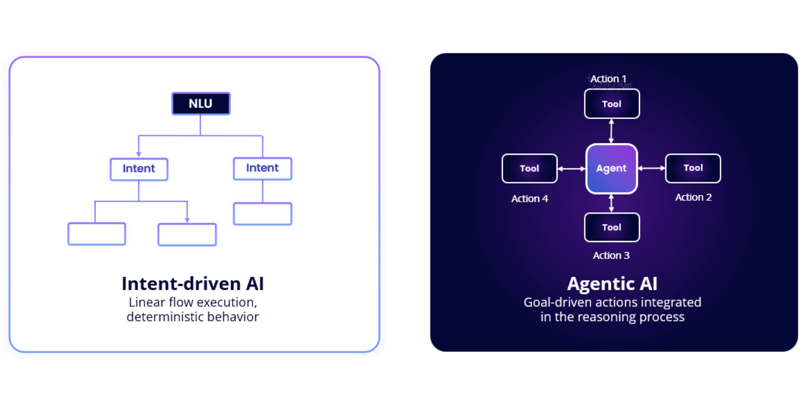By Alan Ranger, Vice President, Cognigy
As generative AI gains traction in enterprise CX, one thing is becoming clear: traditional AI implementations focused on containment or scripted flows are no longer enough.
Enter the era of Agentic AI – autonomous, goal-driven AI agents capable of making decisions, learning from outcomes and acting independently across channels.
But here’s what’s not being talked about enough: it’s not just what these agents do that matters, it’s HOW they collaborate with humans that will define their success.
The evolution of contact center AI is shifting from “bot vs. human” toward “bot with human” – a fundamental redesign of roles, workflows, and strategies. In this new landscape, human agents aren’t displaced, they become orchestrators of complex journeys while AI agents act as autonomous copilots, taking initiative when appropriate and deferring when nuance or emotion is needed.
From Reactive Scripts to Intent-Driven Autonomy
In traditional automation, AI responds to commands. Agentic AI flips this model. These agents are equipped to pursue goals within context, dynamically deciding what steps to take based on evolving customer needs and data.
 What this means in practice: AI agents are starting to independently handle tasks like verifying identity, executing multi-step backend actions (e.g., updating a billing address across multiple systems), and even initiating outbound engagement – like proactively rebooking a delayed flight or sending follow-ups based on sentiment flags.
What this means in practice: AI agents are starting to independently handle tasks like verifying identity, executing multi-step backend actions (e.g., updating a billing address across multiple systems), and even initiating outbound engagement – like proactively rebooking a delayed flight or sending follow-ups based on sentiment flags.
This shift requires a new orchestration layer in which AI agents are given not just capabilities but boundaries and judgment frameworks. Forward-thinking CX teams are defining goal hierarchies and conditional escalation paths so Agentic agents can act freely but also know when to defer.
Co-Execution Models: AI as Process Partner
One of the most promising strategies is co-execution – AI and human agents collaborating on the same task, each contributing in real-time.
Take technical troubleshooting: an AI agent may initiate a diagnostic process, interpret results, and suggest likely fixes, while the human agent handles the conversation and emotional calibration. This shortens time-to-resolution while preserving the empathy that customers expect from complex interactions.
We’re seeing early prototypes of “live collaboration mode,” where AI agents annotate calls, summarize tickets as they unfold, and surface next-best actions without requiring a handoff. It’s not a relay race, it’s real-time tag-teaming.
Proactive CX: AI That Reaches Out First
The biggest leap may be in the proactive use of Agentic AI, systems that don’t just wait to be asked but actively seek out and solve customer issues.
Imagine a customer whose subscription is about to lapse. The AI agent detects the pattern, triggers a personalized reminder, offers a renewal incentive, and, if no action is taken, seamlessly escalates to a live agent for follow-up. No ticket, no hold time, just fluid, intelligent service.
Proactive AI is still in its early days, but its potential for loyalty, retention and pre-emptive resolution is massive. The key challenge? Designing AI agents that know when to act and how often without feeling intrusive – a challenge some teams are now addressing with reinforcement learning-based guardrails.
Human-Centric Design in the Age of Autonomy
Perhaps the most overlooked shift: successful Agentic AI deployments are being driven not just by data scientists or IT but by CX designers and behavioral experts. Because once AI becomes autonomous, how it acts matters just as much as what it does.
We’re seeing a rise in role definition for digital agents complete with tone guidelines, escalation personas, and task ownership boundaries. Leading CX teams are creating “Agent Design Systems” that mirror the way UX teams build brand-aligned digital interfaces. The takeaway? In the era of Agentic AI, human-centric design is no longer a nice-to-have. It’s essential.
 Agentic AI is more than an upgrade to existing bots; it represents a shift in philosophy from static, rules-based automation to dynamic, goal-oriented collaboration between humans and machines. As new co-execution models, proactive workflows, and AI-human orchestration strategies emerge, CX teams must move from implementing tools to designing systems.
Agentic AI is more than an upgrade to existing bots; it represents a shift in philosophy from static, rules-based automation to dynamic, goal-oriented collaboration between humans and machines. As new co-execution models, proactive workflows, and AI-human orchestration strategies emerge, CX teams must move from implementing tools to designing systems.

